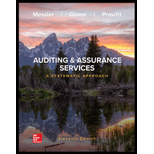
Introduction:
Internal Control is a policy, procedure, set of rules, designed and implemented by management and those charged with governance, so as to obtain reasonable assurance regarding achievement of entity’s objective, to safeguard assets and protect from any chance of fraud or error. Its objective is operational efficiency and effectiveness for reliable financial reporting.
The auditor during an audit checks whether Internal Control exists or not, and if it exists it is effective or not and followed in continuation or not.
An Interim Period Audit means audit for the work carried out before financial year end.
Interim Period is any period less than 1 fiscal year.
To define: Effectiveness of internal Control after Interim Date
Want to see the full answer?
Check out a sample textbook solution
Chapter 7 Solutions
EBK AUDITING & ASSURANCE SERVICES: A SY
- Esfandairi Enterprises is considering a new three-year expansion project that requires an initial fixed asset investment of $2,350,000. The fixed asset will be depreciated straight-line to zero over its three-year tax life, after which time it will be worthless. The project is estimated to generate $3,310,000 in annual sales, with costs of $2,330,000. Assume the tax rate is 23 percent and the required return on the project is 11 percent. What is the project's NPV? Note: A negative answer should be indicated by a minus sign. Do not round intermediate calculations and round your answer to 2 decimal places, e.g., 32.16.arrow_forwardGyygvvv iiiedfarrow_forwardNeed help in this question.hjarrow_forward
 Auditing: A Risk Based-Approach (MindTap Course L...AccountingISBN:9781337619455Author:Karla M Johnstone, Audrey A. Gramling, Larry E. RittenbergPublisher:Cengage Learning
Auditing: A Risk Based-Approach (MindTap Course L...AccountingISBN:9781337619455Author:Karla M Johnstone, Audrey A. Gramling, Larry E. RittenbergPublisher:Cengage Learning Auditing: A Risk Based-Approach to Conducting a Q...AccountingISBN:9781305080577Author:Karla M Johnstone, Audrey A. Gramling, Larry E. RittenbergPublisher:South-Western College Pub
Auditing: A Risk Based-Approach to Conducting a Q...AccountingISBN:9781305080577Author:Karla M Johnstone, Audrey A. Gramling, Larry E. RittenbergPublisher:South-Western College Pub


